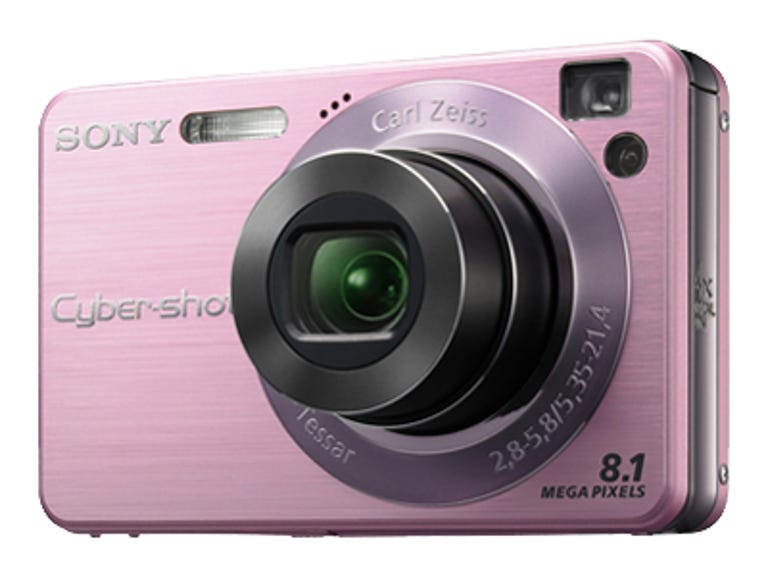 Why You Can Trust CNET
Why You Can Trust CNET Sony Cyber-shot DSC-W130 review: Sony Cyber-shot DSC-W130
Sony Cyber-shot DSC-W130
Sony inches its Cyber-shot W-series of compact snapshot cameras forward with the Cyber-Shot DSC-W130. This 8-megapixel shooter sports a shiny, colorful new shell and a slightly longer lens, but otherwise feels like a carbon copy of its predecessor, the Cyber-shot DSC-W90.
The Good
The Bad
The Bottom Line
Rounded corners and an attractive brushed metal front plate give the W130 a more stylish look than the W90. Available in silver, black, and pink, it offers some choices for gadget color coordination (though not as much as its 7-megapixel little brother, the DSC-W120, which comes in black, silver, pink, and blue). Besides the new look, the W130 gets a tweaked control layout from the W90. While it still uses irritatingly small, circular buttons for menu control, the buttons are laid out comfortably around the camera's direction pad and feel much more accessible to large-thumbed users.
Despite the makeover, the W130 offers few differences from its predecessor. The camera's 32mm- to 128mm-equivalent, f/2.8-5.8 lens is the only significant upgrade, offering a slightly longer zoom and wider angle than the W90's 35mm- to 105mm-equivalent lens. The W130 keeps the W90's 8-megapixel resolution, 2.5-inch LCD, and optical viewfinder. It also includes the W90's face detection function with Smile Shutter, a handy mode that lets the camera automatically take pictures of subjects when they smile. It gets a slight downgrade in the internal memory department, carrying only 15MB of space instead of the W90's 31MB. Of course, you should never rely on internal memory, so either camera would require you to pick up a Memory Stick Duo for shooting more than a handful of photos.
A generous set of onboard photo retouching and viewing features lets you tweak the photos you shoot with the W130. The camera can trim and rotate (in 90-degree increments) your pictures after you take them, and digitally remove red eyes. It can also apply sharpening, soft focus, and a variety of other effects to adjust your pictures. Most of these effects feel more like silly toys than useful features, but they can still be fun to play with. The W130 can also display photo slide shows with MP3 music soundtracks, either on the camera itself or (with an optional cable or cradle) on your HDTV.
The W130 performed quickly in our lab tests, with the exception of its flash, which took a long time to recycle. After a 1.8-second wait from power-on to first shot, the camera could capture a new picture once every 1.4 seconds with the onboard flash turned off. With the flash enabled, however, that wait doubled to 2.8 seconds. The shutter feels pleasantly responsive, lagging only 0.4 second with our high-contrast target and 1 second with our low-contrast target. In continuous shooting mode, the W130 captured 15 full-resolution shots in 7.5 seconds for a respectable rate of 2 frames per second.
Pictures taken with the W130 look good, though noise and softness can hinder picture quality and limit printability for photos taken at ISO 800 or higher. At lower sensitivity levels, fine details appear clearly, despite some slight softening around the edges of pictures. Noise, and Sony's noise reduction, begins to lower sharpness noticeably at ISO 400, though colors stay vibrant and the effect on prints is minimal. Noise becomes prominent at ISO 800, and at ISO 1600 grain consumes the picture. At the camera's maximum of ISO 3200, photos look like they were painted onto felt, with heavy fuzz ruining all fine lines. The W130's lens showed just the slightest amount of pincushion distortion (bending toward the center of the frame) at the telephoto end, but wide-angle shots have noticeable barrel distortion. The camera's automatic white balance does a good job of neutralizing colors in fluorescent or incandescent lighting, though it leaves a subtle warmth to the latter. Our extremely yellow tungsten lights flummoxed the system, however, that's not out of the ordinary even for much more expensive cameras.
With a quick shutter and a shiny, attractive shell, the Sony Cyber-shot DSC-W130 makes a very good pocket point-and-shoot camera. Its 4x lens gives it a slightly longer reach than most other compact cameras in its price range, and its onboard editing and slide show features are helpful when you want to tweak and share your shots. Its photos aren't quite as sharp as they could be, but they're more than suitable for respectable (8 inch x 10 inch) prints, e-mailing, and posting on the Web.
(Shorter bars indicate better performance)
(Longer bars indicate better performance)
